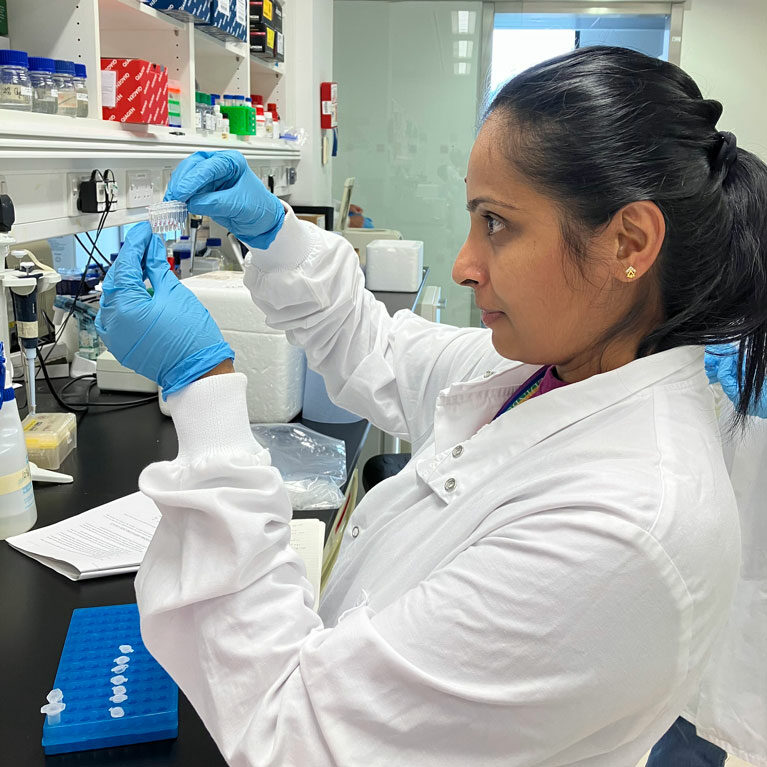Training and tools to save bowmouth guitarfish
Emily is helping to develop a species-specific management plan to support the protection of the Critically Endangered bowmouth guitarfish in Sri Lanka. She is using genetic tools to better understand this species and the trade in it, while also training local marine biologists to use rapid and cost- effective DNA sequencing technology.
Growing up in the cosmopolitan suburbs of rainy London meant that I was hours away from the ocean. For a long time, it was my imagination that nurtured an interest in the marine world, helped along by well-worn books, enormous museums and beautiful documentaries. But in the long run, this would never really do. I have since made sure to connect the ocean with both my work and my home life as much as possible, whether that’s waiting for marine megafauna atop a Maldivian dhoni (dhow-like boat), snorkelling above maerl beds in the cold waters of Gairloch in western Scotland,...
Training and new tools to save bowmouth guitarfish
Characterise population structure and diversity of bowmouth guitarfish in the Northern Indian Ocean using fisheries bycatch samples to provide science-based management recommendations. A subset of this data will be generated during a capacity building workshop in Sri Lanka, training marine biologists and government officials to use rapid, cost-effective sequencing technology.
This assessment of bowmouth guitarfish stock structure and diversity is motivated by the need to fill significant knowledge gaps to develop robust NDFs and species-specific action plans. Genetic research outcomes will therefore be management driven and the first of their kind for this unique species.
This project will also address the widespread issue of poor enforcement capacity by capitalising on cutting-edge developments in DNA sequencing technologies. This approach will ensure that fisheries regulators can rapidly employ monitoring and surveillance tools to increase compliance with trade regulations such as CITES.
Finally, through providing local marine biologists with the tools to carry out DNA-based species identification, this project will help expand an existing field station into a regional research hub. By targeting permanent staff members and providing open access training materials, we will ensure that knowledge and skills are retained in-country and can be passed on to future government and university staff.
The Critically Endangered Rhina ancylostoma is the most wide-ranging wedgefish species. However, like all other shark-like rays, significant knowledge gaps remain about their population size, distribution and trends due to a severe lack of scientific data. This has resulted in little to no species-specific management across the globe, particularly around fishing hotspots such as the North-West Indian Ocean. Genetic data analysis provides an opportunity to characterise population connectivity and stock status, both of which can provide the basis for effective harvest and species recovery management plans. To date, population genetic analysis has only been carried out for one wedgefish species, Rhynchobatus australiae, in the Indo-West Pacific. We will extend this to Rhina ancylostoma in the Indian Ocean with the aim to inform NDFs and National Action Plans.
Across the globe, limited enforcement capacity is regularly cited as a major obstacle to effective conservation management. This is particularly evident in Sri Lanka, whose elasmobranch fishery is among the world’s largest and is dominated by threatened species including Rhina ancylostoma. Consequently, there is an urgent need to improve knowledge and capacity in monitoring, control and surveillance within this elasmobranch fishing nation. Recent developments in DNA sequencing technologies have now made it possible to perform genetic species-ID using hand-held devices. This has the potential to enable small-scale research stations with limited infrastructure to perform rapid and cost-effective fisheries and trade monitoring. By establishing this approach in Sri Lanka, we hope to develop a translatable model for uptake by other South Asian countries.
- Generate scientific data on stock structure and diversity of the bowmouth guitarfish in the Indian Ocean.
- Improve knowledge and capacity in the application of rapid and cost-effective genetic tools for identifying elasmobranch specimens in trade and fisheries in Sri Lanka.
- Use the resulting data to support the development of CITES NDFs and national management initiatives.


